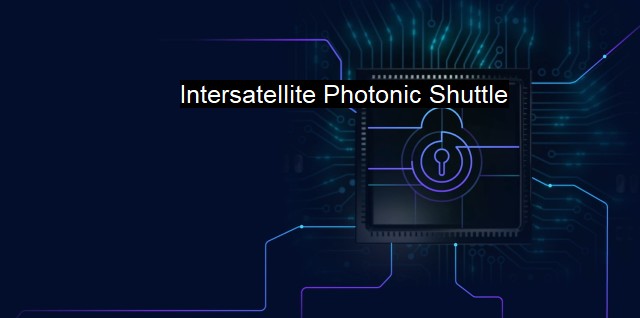What is Intersatellite Photonic Shuttle?
Securing Satellite Communication Networks with Intersatellite Photonic Shuttle: A Revolutionary Technology Using Quantum Mechanics
The world of cybersecurity and antivirus constantly undergoes innovations and advancements to match the growing potential cyber threats. One of such innovations much talked about in technology circles is the "Intersatellite Photonic Shuttle" (IPS). The term may sound straight out of a science fiction novel for most, but with it refers to a unique protocol that can revolutionise how we ensure secure communications on both interstellar and terrestrial levels.The IPS, while a non-conventional concept with primarily delves into optics and photonics. Appreciating Intersatellite Photonic Shuttle's-themed innovation is binding with the current trend of amplifying secure communication requirements, emphasizing secured data flow and routing proofs, network defenses, algorithms, key management, data protection, and safety processes while collaborating with the principles of unique photon-based technology.
The Intersatellite Photonic Shuttle typically involves launching photonic shuttles from one satellite to another. These photonic shuttles are unique in nature and use photons – elementary particles of light – to transmit information from one point to another. The idea behind IPS is that it opulently combines the robust, established principles of photonics with satellite-based networks to forge an impervious layer of cybersecurity that could quite possibly be impermeable to the modern malicious cyber actors. It points out to a futuristic cyber defense mechanism in which data breaches and information hacking could be brought down to near negligible levels.
The photon carries quantum information and the quantum condition makes it extremely challenging and nearly impossible to intercept the photonic shuttle data without leaving a trace. An effort to interfere with the shuttle data would result in its instant corruption. This basic security attribute gives us a glimpse of how protocols like these depict an optimism for a nearly impenetrable data communication framework in the upcoming times.
The IPS is potential defense outgrowth of the groundbreaking field of quantum computing and quantum communication. These harness the untouched attributes of quantum mechanics, such as quantum encryption or quantum key distribution, making IPS a pertinent system for potential future digital exchanges.
A step beyond in the optimal exploitation of IPS can lead to the establishment of an evolving concept of data lockers or photonic capsules. Operating within the principles of IPC, these are essentially uncrackable storage devices crucial in holding sensitive information at a denser level safeguarded against external disruption.
Also, the universality and conformation flexibility of the IPS system gain brownie points. Given the framework that IPS is adaptable to various sizes and shapes structures, it achieves vast potential in both micro and macro-levels, from tiny IoT devices to not-so-diminutive satellite systems. In an age when threats to cybersecurity and fine digital infrastructure have spread worldwide, the need to safeguard numerous sensitive information reasserts the advanced defense mechanisms like IPS.
The essences of the Intersatellite Photonic Shuttle in combination with cybersecurity elaborately suggest a proactive futuristic approach to cyber protection. It envisions a secure sphere, transcending geographical limitations, ruled by invulnerable data exchanges, availing itself from continuous resilient adaptations.
While the idea of an Intersatellite Photonic Shuttle looks reassuring from a cybersecurity perspective, creating and implementing such a system is quite complex. It brings us items beyond the equation involving advanced science and technology interactions.
The Intersatellite Photonic Shuttle is an engaging piece of cyberscience and information technology. The combination of the shuttling nature of the photon between satellites provides a vision of an unassailable data fortress that will be unreachable by traditional hacking tools. But, the execution of such intensely glorified data security measures requires an advancement in existing technology and rigorous testing phases. Like the classical saying, 'In theory, theory and practice are the same. In practice, they're not,' it teaches patience with the advancement in security levels of the future data networks.

Intersatellite Photonic Shuttle FAQs
What is an intersatellite photonic shuttle?
An intersatellite photonic shuttle is a technology that uses photonic (light-based) signals to transfer data between satellites in orbit without the need for physical connections. This technology is used to increase the speed and efficiency of communication between satellites in space.How does the intersatellite photonic shuttle improve cybersecurity in space?
The intersatellite photonic shuttle improves cybersecurity in space by providing a faster and more secure way to transfer data between satellites. Compared to traditional radiofrequency communication, photonic signals are more difficult to intercept and decode, making it harder for malicious actors to gain access to sensitive information.Can an intersatellite photonic shuttle be hacked?
While no technology is completely immune to hacking, the intersatellite photonic shuttle is designed to be more secure than traditional satellite communication methods. The use of photonic signals makes it harder for hackers to intercept, decode, or disrupt the transmission of data between satellites.What is the role of antivirus software in an intersatellite photonic shuttle system?
Antivirus software plays a critical role in protecting an intersatellite photonic shuttle system from cyber threats. This type of software is designed to detect, prevent, and remove malicious software (malware) that can compromise the security of the system. By regularly updating and scanning the system with antivirus software, the risk of cyber attacks can be greatly reduced.| | A | | | B | | | C | | | D | | | E | | | F | | | G | | | H | | | I | | | J | | | K | | | L | | | M | |
| | N | | | O | | | P | | | Q | | | R | | | S | | | T | | | U | | | V | | | W | | | X | | | Y | | | Z | |
| | 1 | | | 2 | | | 3 | | | 4 | | | 7 | | | 8 | | |||||||